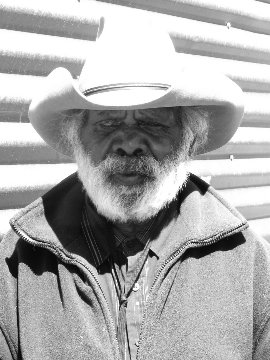Sandy Brumby was born in the bush at Victory Downs, an outstation near Pukatja (Ernabella). He grew up there with his mother, father, brother and sister. As a ‘young fella’, he worked at Mount Cavanagh, a cattle station near Kulgera in the Northern Territory. He was a stockman there, mustering bullocks, fencing, and tending to the cattle.
Sandy met his wife, Tjukapati Nola Brumby, in Pukatja (Ernabella), and from there they moved to the Amata community for some time. Eventually they settled in Pipalyatjara, where they had two children - a boy and a girl. Sandy has been in the Pipalyatjara area for a long time, since before Kalka and Pipalyatjara communities were fully established.
In 2010, in his sixties, Sandy Brumby picked up a paint brush for the first time, and he has come to the art centre religiously ever since, having discovered a passion for paint and a strong need to tell his story. The iconography in his work is reminiscent of symbols that are sometimes seen in rock or cave paintings around Uluru and Kata Tjuta.
His paintings are raw and bold, demonstrating a strong connection to his country and his culture. He has a deep love of colour and uses a broad palette when he paints, selecting - with natural intuition - colours that sing beautifully together. Sandy Brumby’s approach to telling his story through art is highly individual. Although his paintings are simple in composition and raw in their application of paint, his brush strokes are very delicate, belying the astoundingly powerful spirit in his painting.
In the relatively short period of time he has been painting, his works have been acquired by significant public collections, including the National Gallery of Victoria (NGV) and Queensland Art Gallery (QAGOMA).
Sandy Brumby was born in the bush at Victory Downs, an outstation near Pukatja (Ernabella). He grew up there with his mother, father, brother and sister. As a ‘young fella’, he worked at Mount Cavanagh, a cattle station near Kulgera in the Northern Territory. He was a stockman there, mustering bullocks, fencing, and tending to the cattle.
Sandy met his wife, Tjukapati Nola Brumby, in Pukatja (Ernabella), and from there they moved to the Amata community for some time. Eventually they settled in Pipalyatjara, where they had two children - a boy and a girl. Sandy has been in the Pipalyatjara area for a long time, since before Kalka and Pipalyatjara communities were fully established.
In 2010, in his sixties, Sandy Brumby picked up a paint brush for the first time, and he has come to the art centre religiously ever since, having discovered a passion for paint and a strong need to tell his story. The iconography in his work is reminiscent of symbols that are sometimes seen in rock or cave paintings around Uluru and Kata Tjuta.
His paintings are raw and bold, demonstrating a strong connection to his country and his culture. He has a deep love of colour and uses a broad palette when he paints, selecting - with natural intuition - colours that sing beautifully together. Sandy Brumby’s approach to telling his story through art is highly individual. Although his paintings are simple in composition and raw in their application of paint, his brush strokes are very delicate, belying the astoundingly powerful spirit in his painting.
In the relatively short period of time he has been painting, his works have been acquired by significant public collections, including the National Gallery of Victoria (NGV) and Queensland Art Gallery (QAGOMA).
